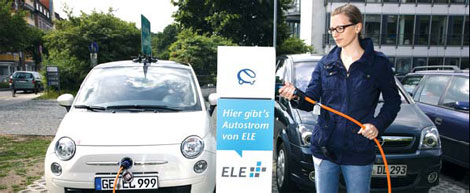Green mobility in the driver's seat
Updated: 2012-02-02 07:50
By Yang Cheng (China Daily)
|
|||||||||||
|
An electric car made by the Emscher Lip Energy GmbH Ele, an energy supplier in Ruhr area. [Provided to China Daily] |
The changing dynamics of transportation and traffic
Tourists who visited Beijing in the 1980s would stumble across major differences in the city if they return once again in 2012.
They would recognize a dramatic alteration of local traffic conditions. Millions of bicycles on the city roads in the 1980s have been replaced by millions of vehicles.
In a 20-year period, China's urban reality has changed more than it did in the entire past century.
Traffic congestion in today's mega-cities all over the world has risen to unprecedented levels. Accordingly, the world needs to develop new concepts to improve urban mobility.
The changing dynamics of urbanization, coinciding with more limited oil resources and increasing environmental damage in and around cities, demonstrate that creative solutions could offer a more efficient, responsible and green mobility movement.
The 21st century marks a turning point for new mobility technologies.
China and Germany are the key players of developing alternative methods of transportation. Research and development of electric-mobility (e-mobility) are considered pivotal industries for both nations.
They share common interests to find a balance between protecting the environment, as well as meeting the mobility needs of modern society. There is a rising demand for energy while more pollution surrounds our cities.
Both countries seek to reconcile economy and ecology. The goals are ambitious: Germany wants 1 million e-cars up and running by 2020, China aims for more than 5 million e-cars in the same time period.
For many years, Germany and China have been cooperating to develop more environmentally friendly modes of transportation.
The issue had risen to new heights when in June 2011 Chinese Premier Wen Jiabao and German Chancellor Angela Merkel met along with more than 10 ministers from each government for the first Sino-German Government Consultations in Berlin.
The meeting garnered much attention since it demonstrated the high quality of the relationship between the two governments.
They placed greater efforts and resources to tackle key challenges that the world would continue to face in the years and decades ahead. One element of such a new cooperation framework involves e-mobility.
A strategic partnership has been set up to link ongoing and new cooperation projects.
The focus was on policy development, norms and standards, integrated solutions for urban mobility as well as on research and development.
The partners will work towards achieving joint standards, collecting best practices and establishing model regions for e-mobility in both countries.
Additionally, new forms of mobility are given equal importance to enhance existing automotive technologies, such as functional performances, power transmissions, fuel efficiency and driver assistance systems.
China has the biggest global automobile market and Germany lays claim to the greatest know-how in automotive technology.
125 years ago, in 1886, Carl Benz developed the first gasoline engine in Mannheim.
Meanwhile, Gottlieb-Wilhelm Daimler and Wilhelm Maybach invented the first four-stroke engine.
For more than 100 years, the combustion engine, originally "made in Germany," dominated the car technology sector worldwide. Yet a new generation of technology has taken the driver's seat: Germany and its car industry are ready to move forward.
Today's Top News
President Xi confident in recovery from quake
H7N9 update: 104 cases, 21 deaths
Telecom workers restore links
Coal mine blast kills 18 in Jilin
Intl scholarship puts China on the map
More bird flu patients discharged
Gold loses sheen, but still a safe bet
US 'turns blind eye to human rights'
Hot Topics
Lunar probe , China growth forecasts, Emission rules get tougher, China seen through 'colored lens', International board,
Editor's Picks

|

|

|

|

|

|






